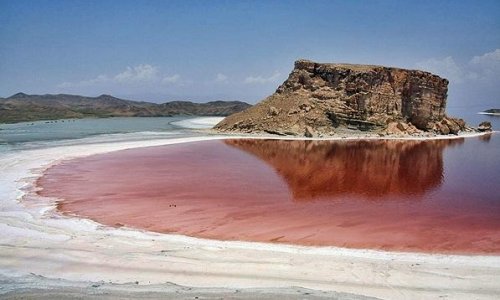Ice cold in the desertIn the Zard-Kuh, a 4,200m-high mountain range bordering the western flank of Iran's vast central deserts, hides one of the Islamic Republic's most unexpected geographical finds: on the edge of the hot desert is a series of sub-tropical glaciers.
"Most of the foreign tourists in Iran come from Europe where there are lots of tall mountains, so I have a hard time convincing them to see the Zard-Kuh,” said Farshid Zandi of Zandi Tours. "I have only taken three groups of foreigners there so far, but each time they told me it was the highlight of their holiday in Iran.” (Credit: Ian Lloyd Neubauer)
Half the worldI met Zandi in Isfahan, the resplendent former capital of Persia. I'd come to see the soaring mosques and palaces and the elegant squares and gardens that inspired the 17th-century proverb Isfahan nesf-e jahan (Isfahan is half the world). So I was somewhat taken aback when Zandi suggested I take a day out of my compact schedule for a 500km return journey to the Zard-Kuh to see the Bakhtiari, a nomadic tribe who'd made camp near the glaciers. (Credit: Ian Lloyd Neubauer)
Into the hillsWe left at 8 am the next day. The first half of the journey cut through the semi-arid desert encircling Istafan. But soon colossal snow-capped promontories shot into the sky and patches of green – the first I'd seen in Iran outside of oases – riddled the landscape.
When we passed the city of Shar-e-Kord, the so-called "Roof of Iran” at 2,070m above sea level, I saw a series of signposts bearing black-and-white portraits of men and boys. Zandi explained that they were martyrs who died in the bloody 1980-1988 Iran-Iraq War. Half a million people were killed in the conflict, including 95,000 child soldiers, some as young as 12 years old. (Credit: Ian Lloyd Neubauer)
The last resortMost people don’t know that Iran has lots of snow and world-class pistes. Although the most popular places to ski are in the Alborz Mountains north of Tehran, the village of Chelgre, the last population centre before the glaciers, morphs into a low-key alpine resort from November through April.
The graffiti sprayed on this boulder on Chelgre's outskirts reads "Baba Haje Restaurant. Kebab from baby sheep, chicken kebab, dizi [an Iranian casserole], milk, yogurt, hot water. We welcome you, dear tourists.” (Credit: Ian Lloyd Neubauer)
Surreal waterfallsSheikh Khan Waterfall, 9km after Chelgre, is one of countless cascades found in the Zard-Kuh. Although we were no longer in the desert, the high-altitude plateau still bore great swaths of mustard-coloured soil. When contrasted against the waterfall, the visual effect was surreal, as though a vertical spring had miraculously burst from a precipice in the desert. After filling our water bottles with crystal-clear water, we continued on our way. (Credit: Ian Lloyd Neubauer)
Goat herdersA short distance from the waterfall, we passed a family of Bakhtiari nomads herding goats along the road. Historically, the Bakhtiari were both pastoralists and hunters who shot ibex, wolf, fox, jackal, hyena and leopard, all once found in considerable numbers in the Zard-Kuh. But as the Bakhtiari and others in western Iran gained access to modern weaponry, the wildlife population began to dwindle. In 1973, this part of the Zard-Kuh, known as Tang-e-Sayyad or Hunters Valley, was proclaimed a protected zone and hunting was outlawed. (Credit: Ian Lloyd Neubauer)
Spinning woolThe Bakhtiari spend eight months a year in Khuzestan, a province in the south of Iran. They migrate to the Zard-Kuh at the end of every April to escape summer temperatures that soar to 50C, and remain here until mid-September, fattening up their livestock on fresh green grass.
This annual migration used to be a gruelling week-long odyssey on foot through desert and snow. Today, however, the Bakhtiari travel by car and use trucks to transport their animals, though many of their other traditions still remain intact. In this photo, an elderly Bakhtiari woman spins wool the old-fashioned way to make clothing. (Credit: Ian Lloyd Neubauer)
River of lifeAbout 20km past the Sheikh Khan Waterfall, the bitumen ended and was replaced by a roughly-hewn dirt road. The air here was crisp and cool – an anomaly in the Iranian summer – while the vistas, like those in this photo of a Bakhtiari tent overlooking Hunters Valley, were astounding.
The 400km ZayandehRood (Live River) that slices through the valley is one of the longest waterways in all of Iran. With the help of aquifers, it carries billions of cubic litres of melted snow to desert cities like Isfahan and Yazd, and as far south as the Bakhtiari's winter residence in Khuzestan. (Credit: Ian Lloyd Neubauer)
Nomad cityAfter three and half hours on the road, we arrived at Chama Qar Yakhi, one of Zard-Kuh’s largest settlements that's home to some 100 Bakhtiari. The Bakhtiari have officially owned this land for generations, though they still enjoy the freedom of the nomadic way of life. They don't pay taxes, live by their own rules and are more-or-less self-sufficient. Yet according to tribesman Reza Abdullah, pictured above with his 11-year-old son Ahmad and a leg of lamb, the nomadic lifestyle isn't always a bed of roses.
"I've never experienced life in the city though I think the people there have it better because we don't have good amenities here. But many of the people who come to visit us say they wish they could live like us,” he told me. (Credit: Ian Lloyd Neubauer)
The best kebabsUntil a few years ago, Abdullah's income came from the sale of meat, milk and wool to local wholesalers. But recently, he and other Bakhtiari who spend their summers at Chama Qar Yakhi have been able to supplement their income by feeding the small groups of Iranian tourists – newly middle class due to the improving economy ¬– who drive up from Istafan for picnics at the Zard-Kuh.
The kebab is Iran's national dish and the version pictured here, kebab chenjeh, made with the meat of newly slaughtered sheep, is the most succulent and expensive. Grilled on a charcoal barbeque, the meat is so tender and flavoursome that it doesn't need any sauce. We ate it with Iranian flatbread, onion and salt. (Credit: Ian Lloyd Neubauer)
Colourful carpetsOther nomads at Chama Qar Yakhi have found different ways to cash in on tourists, selling honey, herbs and yogurt as well as colourful handmade woollen rugs. This one pictured above took a fortnight to weave. (Credit: Ian Lloyd Neubauer)
Nomadic dress upOne particularly entrepreneurial family at Chama Qar Yakhi has concocted a novel business idea: a makeshift studio where tourists can dress up in traditional Bakhtiari dress and pose for portraits. When I asked the family patriarch how often foreign tourists come here, he told me next to never, that I was the first to visit this year. (Credit: Ian Lloyd Neubauer)
The last legAfter lunch, Ahmad took Zandi and I to see the glaciers. The closest one to the settlement lies at the base of a cavern with a raging white-water river running through it. The glacier was about the size of a bus and covered in so much dust and grime that it was only distinguishable as a solid block of ice up close.
Another, much larger glacier (pictured) sits deeper inside the cavern; its tail runs more than 100m up the mountain. Juxtaposed against the desert-like surroundings, the ice looks unreal, like it shouldn't really be there. (Credit: Ian Lloyd Neubauer)
Ice caveThe ice wasn't hard as I'd imagined; it was soft to touch like well-packed snow. But it was still slippery to walk on, and Zandi and I progressed at a snail's pace while Ahmad scampered along. He led us to the edge of the glacier and onto a boulder in the middle of a freezing-cold stream where we could see a gap that was slowly forming between the base of the glacier and the flowing water. Ahmad explained that by August a tunnel large enough to walk into will form under the glacier. The settlement of Chama Qar Yakhi, which means "ice cave” in the Bakhtiari dialect, was named after the phenomenon. (Credit: Ian Lloyd Neubauer)
(BBC)











www.ann.az
Follow us !











